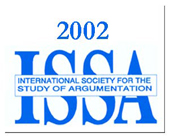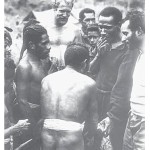ISSA Proceedings 2002 – Enthymeme And Prosody – A Contribution To Empirical Research In The Analysis Of Intonation As Well As Argumentation
No comments yet The idea for this paper arose, when questions about analytical problems in two quite different corpora were exchanged:
The idea for this paper arose, when questions about analytical problems in two quite different corpora were exchanged:
Ines Bose is working on an empirical analysis of children’s role playing communication, focussing on the function of prosodic features for the establishment of play-roles. Norbert Gutenberg is analyzing the interdependency of linguistic and prosodic factors and their impact on the comprehensibility of broadcast-news. Both corpora consist of a large amount of video-taped (Bose-Corpus) and audio-taped (Gutenberg-Corpus) authentic (= not experimentally induced) communication processes and are transcribed and prosodically notated.
The prosodical notation of the B(ose)-Corpus comprises the whole scale of oral delivery: voice quality, pitch range, speech rate, pauses, stress and so forth. The G(utenberg)-Corpus focuses only on stress, pauses and the intonation (melody) before pauses. But with this – partly common – focus, in both corpora arose the same question: how to explain why speakers made just THIS pause, realized just THIS stress on THIS word. Those questions and their relevance need an explanation:
Stress, pauses, cadences (melody before pauses) are – in Indo-European dialects such as German, English, French, Russian etc. – systematically bound to linguistic features, or, in better words: syntactical patterns are realized together with prosodic patterns such as stress and pauses. Even more so: sometimes the meaning of a word combination, the grammatical function of a word is not perceptible from the written text, but only from the oral realization.
Just one example for the impact of pauses for the constitution of sentence meaning:
He doesn’t know how good meat tastes.
The early Chomsky declared this to be ambiguous. But every speaker of English – so an early critique of Chomsky – would have this combination of words in his mind either this way:
He doesn’t know how good meat / tastes.
or this way:
He doesn’t know how good / meat tastes.
So, there is no linguistic ambiguity, if prosody – here: pauses – is taken into account.
For the impact of stress we have an example in German:
Heute so, morgen so.
As a text, this means nothing. It becomes meaningful, if you stress it either this way:
HEUte so, MORgen so.
Same thing every day.
or that way:
Heute SO, morgen SO.
Changing every day.
These examples show that meaning is not only constituted linguistically but also prosodically. And if so, the question arose, for both of the corpora, why are some utterances stressed as they were, and not as they could have been. (In this paper we are focusing only on stress, not regarding anymore pauses and melody).
And this was the point where the idea of enthymeme came up. If there is a decision behind a stress, there is a reasoning behind the decision – may it be conscious (for a newscaster examining his texts for how to stress them), may it be unconscious (for a girl just trying to get an answer from her peer in order to get done what is to be done in the play).
If there is ’reasoning behind’, for a rhetorician, the concept of ’enthymeme’ is imminent. That means that by ’enthymeme’ here is understood the concept of enthymeme as ’shortened syllogism’ which has a ’hidden premiss’, not the ’protasis-enthymeme’ or the ’topical enthymeme’ etc.
For the rhetorician, there is also imminent the concept of ’pronuntiatio’ in the rhetorical tradition. Oral delivery has always been regarded as a most important means of persuasive influence.
Just two examples:
Quintilian writes in Book I of his ’institutio oratoria’, that an orator has to consider “where to stop the words and hold them somehow on the same level […], where to let fall the tone. […] Because, in addition to the basic distinction which consists in the tripartition of syllable’s accentuation either high, low or progredient, there are other forms of tone at hand, intensive ones or loosening or higher or lower, also time measure, be it ritardando, be it accelerando” (translated by the authors from Historisches Wörterbuch der Rhetorik, Article ’Intonation’, Bd. 4, 541).
And in the 17th century the German rhetorician Christian Weise distinguished in his ’political orator’(1681) between ’sonus’ (voice quality) and ’accentus’, which is most interesting for our belongings because it comprises ’stress, pitch and speech rate’ (a classification which can be traced back to Cicero). Under ’stress’ Weise distinguishes steps of loudness – the syntagma with the main information is louder, under ’pitch’ he knows steps of melody – the main syntagma is higher or lower, under ’speech-rate’ there are steps of velocity – the main syntagma is slower (Here we follow Historisches Wörterbuch der Rhetorik, ’Article actio’, Bd. 1, 59). Inspite of these insights in the communicative importance of at least ’accentus’, never in the history of rhetoric – as far as we know (and as always, our knowledge never goes far enough!) – the connection between prosody and enthymeme has been explicitly established.
We tried to establish this connection by taking stress and pauses as elements of an enthymematic structure. That means that we reconstructed the complete syllogism behind a prosodic decision which led to a specific stress or pause as it’s conclusion.
In this paper we give two examples only for stress by pleading to believe us when we assure that the analogous cases are numerous for stress as well as for pauses. So please, take the examples not just for illustration but for true paradeigmata. The first example is taken from broadcast news of a German youth radio, MDR Sputnik (G-Corpus). Here is the text:
1. Italien ist heute morgen von einem Erdbeben erschüttert worden.
This morning Italy has been shaken by an earthquake.
2. Das Beben ereignete sich in Sizilien und erreichte eine Stärke von vier Komma zwei auf der Richterskala.
The earthquake happened in Sicily and reached 4.2 on the Richter scale.
3. Nach Angaben der Behörden gab es aber keine Verletzten.
Following the authorities no one was injured.
4. Erst vor fünf Tagen hatte in Süditalien die Erde gebebt.
Only five days ago there was an earthquake in southern Italy.
Now take line (2). Here we have two possible realizations concerning stress. The first one stresses only the number indicating the force of the earthquake. The syllogism behind this prosodical conclusion is given below:
Das Beben ereignete sich in SiZILien und erreichte eine Stärke von vier Komma ZWEI auf der Richterskala.
The earthquake happened in SICily and reached four point TWO on the Richter scale.
1. News should not give information that is common knowledge.
2. Everybody knows how the earthquake scale is called.
3. I tell only the force of the earthquake.
But there could have been another reasoning which could have lead to another conclusion:
Das Beben ereignete sich in SiZILien und erreichte eine Stärke von vier Komma ZWEI auf der RICHTerskala.
The earthquake happened in SICily and reached four point TWO on the RICHTer scale
1. News should deliver knowledge necessary to understand the information.
2. Maybe you don’t know how the earthquake scale is called.
3. So I tell both the force of the earthquake and the name of the scale.
As news-casters often do, the one who spoke these lines choose the version which permitted him to make the most possible stresses. But still the other reasoning could be valid as well. And there has to be an enthymematic reasoning in the speaker’s mind leading to that prosodical conclusion or another.
The next example is taken from the B-corpus. It’s just two lines from a discussion of two girls trying to prepare the stage of a role play which is going to be started. The lines are from one of the girls who tries to get a decision what to put on a certain place to get the stage ready.
Here are the lines:
1. und da (müssn we) nur noch hier was hin machen
and there (we must) only put something there
2. was wolln wa n da hin machen
what do we want to put there
As to the stresses, the first line bears no problems. There is only one possibility (’hier’), concerning the situational horizon. But it’s the second line which needs a reasoning. Either she could have pronounced it this way with this syllogism behind:
was WOLLN wa n da hin machen
1. usually we decide together what to do.
2. it’s clear we have to put something there.
3. so what’s our decision?
Or she could have realized it this way, with another syllogism behind:
WAS wolln wa n da hin machen
1. till now we don’t know what to put there.
2. it’s clear we have to put something there.
3. so tell me what!
What she realized was the first version, a decision due to the fundamental cooperativity and consensuality of children’s role playing communication. But nevertheless, these examples show that prosodic realizations are not something superficial, but deeply founded in a – maybe not so conscious – reasoning on what is important or not in a given situation.
It’s interesting that insights coming from the old age of rhetoric are so helpful in modern prosodic analysis. We used the concept of enthymeme and, above all, the reconstruction of syllogisms just in the way as it is proposed by Aristotle as a means to discover premisses. And, as it turns out, the premisses we found were always ’endoxa’: accepted journalistic standards in one case, a general rule of how to proceed when setting up a play frame in the other. So where is the difference between the enthymeme as a shortened syllogism and a topical enthymeme? And the reconstruction of syllogism itself was the use of a topical instrument (Beriger 1989). If these instruments of old age rhetoric were so helpful, one should believe that prosodic analysis cannot be done without argumentation analysis. But the conclusion is valid also the other way round: if we are right, it follows that argumentation analysis of natural spoken language cannot be done without an analysis of prosody. And even more so: what is valid for ’accentus’ (here only ’stress’), could be valid for ’sonus’ too, which is the much bigger rest of oral delivery.
REFERENCES
Beriger, A. (1989). Die aristotelische Dialektik. Ihre Darstellung in der Topik und in den Sophistischen Widerlegungen und ihre Anwendung in der Metaphysik. M 1-3. Heidelberg.
Bose, I. (2001). “dóch da sín ja ´ nur mûster//”. Kindlicher Sprechausdruck im sozialen Rollenspiel. Habilitationsschrift. Halle/Saale.
Gutenberg, N. (Hg.)(2002). Schreiben und Sprechen von Hörfunknachrichten. Zwischenergebnisse sprechwissenschaftlicher Forschung (wird erscheinen).
Ueding, Gert (Hg.) (1992fff). Historisches Wörterbuch der Rhetorik. Tübingen.
You May Also Like
Comments
Leave a Reply





